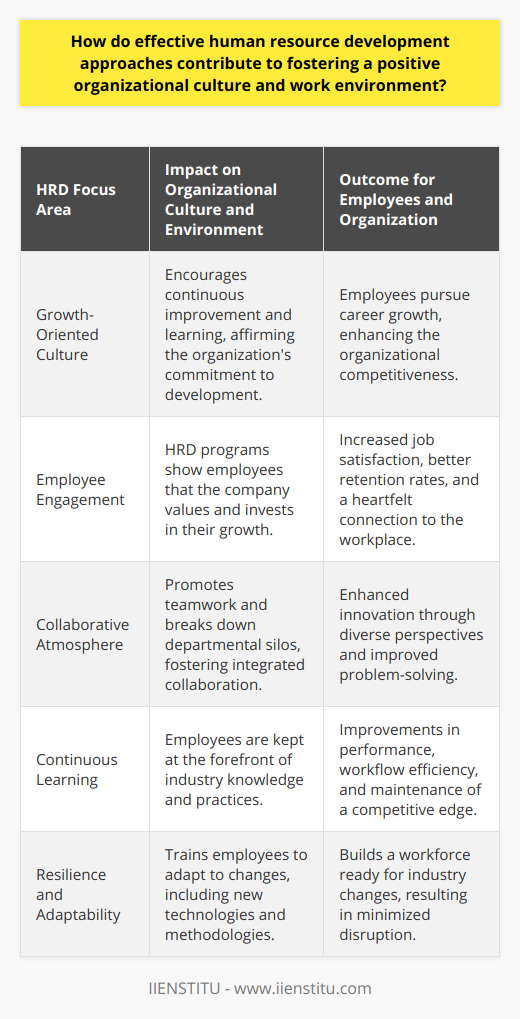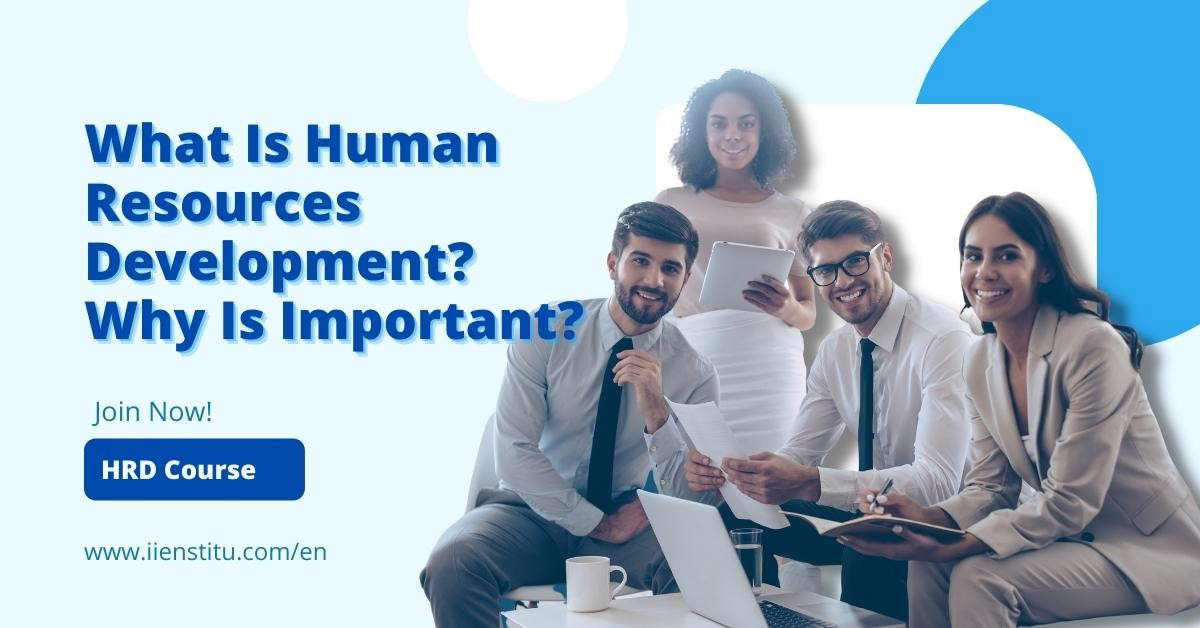
Human resources development (Human Resources Development) refers to learning how to serve an organization's needs better. It involves employees at all levels, from entry-level roles to top management, along with managers and employers, who must understand how their performance impacts the entire company.
In a nutshell, Human Resources Development is about providing individuals with new skills to be more productive and valuable members of their team. This might involve taking courses or attending workshops, but the ultimate goal is to help employees grow and develop in their careers.
One important aspect of Human Resources Development is that it helps employees keep up with changes in the workplace. Technology, for example, is constantly evolving, and businesses must adapt to stay competitive. Employees can stay ahead of the curve and contribute more value to their team by learning new skills.
Another benefit of Human Resources Development is that it can help promote workplace diversity. When employees come from different backgrounds and have other skills, it can lead to more innovative and productive company culture. This is particularly important in today's workplace, where diversity is vital for survival.
By promoting cooperation and camaraderie, Human Resources Development can help build a more positive work environment where employees are excited to come to work each day. This encourages creativity and productivity and can lead to a more successful company.
Human Resources Development is an essential part of any organization, and employees must take the time to learn new skills and stay up-to-date with changes in the workplace. By doing so, they can be more productive and valuable team members.
Relation Between Human Resources Development and Business World
There is a new trend in the business world: Human Resource Development (Human Resources Development). It has been popping up all over, with companies from different industries. It sizes implementing it into their daily operations to improve efficiency, boost productivity, or make things more fun! So does the question now become what does Human Resources Development entail?
Human Resources Development is simply defined as "an organization's capacity for developing its employees so that the individuals and the organization can survive and thrive in a fast-changing environment" by Douglas Mcgregor of MIT. It comprises five key components:
Human Resource Planning
Training,
Development,
Mainly Via Training And Education
Performance Management.
What are the benefits of Human Resources Development?
The benefits of Human Resources Development are vast and cover all aspects of a business, from the individual employee to the organization as a whole. Employees can expect to see increased productivity, job satisfaction, motivation, creativity, and innovation. They will also be better equipped to handle change and be more engaged, committed, and involved.
Organizations can expect to see employees feeling fulfilled and challenged, increased worker morale, and decreased absenteeism and turnover rates. The organization will also see increased interest from job applicants, less time spent on recruiting, lower training costs due to its staff being educated to participate in the process, improved product quality, and improved customer satisfaction and retention rates.
Human Resources Development is about allowing workers to learn new skills that they can apply to their jobs and will enable them to hone existing ones. By giving employees concrete ways to improve themselves, they will take the initiative instead of waiting for instructions from their boss. As a result, they will feel empowered and more confident in their abilities, resulting in better decision-making and problem-solving skills.
The business needs are constantly evolving, so employees need to develop. Human resources Development allows them to become more adaptable, innovative, and flexible, which are critical factors in remaining competitive within an organization’s industry. In addition, by encouraging employees to learn about new technologies or processes, they will feel they are still relevant and valuable within the company. This will also increase their job satisfaction, eliminate boredom and enhance overall productivity.
The training provided by Human Resources Development can reinforce good behavior in employees, especially if certain things must be done or followed up on after hours or off shift. In addition, allowing workers to participate in training during the workday will significantly increase their productivity as they do it on company time.
Why Should You Join Human Resources Development Course?
The use of technology in Human Resources Development is becoming more and more popular as it allows employees to learn at their own pace and in their own time. You can join the online Human Resources Development Course at IIENSTITU.
Human Resources Development is not just for large corporations. Companies of all sizes can benefit from it in some way or another. On average, big businesses spend $1,500 per employee on training while smaller firms spend $400 on exercise, so they are not at a disadvantage. The important thing is to find the right type of training that will benefit the employees and the business.
Overall, Human Resources Development has many benefits for employees and businesses alike. It allows employees to learn new things, improve their skills, stay current with technology and adapt to change. It can help increase productivity, boost efficiency, reduce costs, and improve employee satisfaction for businesses. It is a great way to keep employees engaged and motivated while keeping the company competitive in today’s constantly changing world. You should learn quickly to keep pace with the developing world.
Why Consider Implementing Human Resources Development into Your Operations?
Businesses have started to realize its potential and benefits. It is a great way to improve employees' skills and keep them up-to-date with the latest technology and trends. It can also help businesses boost productivity, efficiency, and overall success. So, if you are looking to improve your business, consider implementing Human Resources Development into your operations!
How to Human Resources Development Develops a Company's Employees?
An employer's main priority is always to improve their workforce. One of the best methods [of doing this] [is by developing employees], which often leads managers on an educational path where they learn about different aspects within business operations and beyond!
Employees are a company's most valuable asset. Therefore it's vital to allow them to grow and learn. Providing employees with more responsibility will enable them to take on new challenges and learn new skills. This, in turn, not only benefits the individual employee but the company as a whole.
There are many different ways to develop employees. One popular method is through training and development programs. These programs can be tailored either internally or externally.
More employees treating their job as a career can help companies offer them more permanent positions. This way, bosses have the opportunity to reward their hard work and commitment, allowing for a more positive work environment.

Frequently Asked Questions
What is the relationship between human resource development and organizational success?
Relationship between HR Development and Organizational Success
Defining Human Resource Development
Human Resource Development (HRD) encompasses activities that contribute to the growth of employees and the organization. These activities include training, skill development, leadership development, and organizational development strategies. HRD aims to align employee skills, knowledge, and abilities with the organization's goals, creating a mutually beneficial situation.
Organizational Success Factors
Organizational success is influenced by several factors, including employee performance, innovation, adaptability, and market competitiveness. An effective HRD strategy directly affects these factors by enhancing employees' competencies and enabling organizations to respond to changing business environments.
Impact of HRD on Employee Performance
Investment in HRD leads to improved employee performance. Providing training and development opportunities equips employees with the latest industry knowledge, enabling them to excel in their roles. The improved performance of individual employees enhances overall productivity and ultimately contributes to organizational success.
Fostering Innovation through HRD
HRD plays a critical role in fostering innovation within organizations. By providing a supportive environment for creativity, learning, and experimentation, HRD enables employees to develop new ideas and solutions. These innovative approaches can lead to operational improvements, market differentiation, and long-term success.
Enhancing Adaptability with HRD
Organizational adaptability is the ability to respond to changing market conditions and emerging trends. HRD strategies, such as cross-functional training and leadership development, enhance the flexibility of the workforce. This adaptability allows organizations to stay competitive and navigate through dynamic business landscapes effectively.
Achieving Market Competitiveness
A highly competent workforce propels organizations towards market competitiveness. HRD initiatives create a skilled talent pool by attracting, developing, and retaining top talent. By cultivating a capable workforce, HRD contributes to organizations' ability to outperform competitors in the marketplace.
In summary, human resource development plays a vital role in the pursuit of organizational success. By investing in HRD activities and creating a highly skilled, adaptable, and innovative workforce, organizations can achieve their goals and maintain a competitive edge.
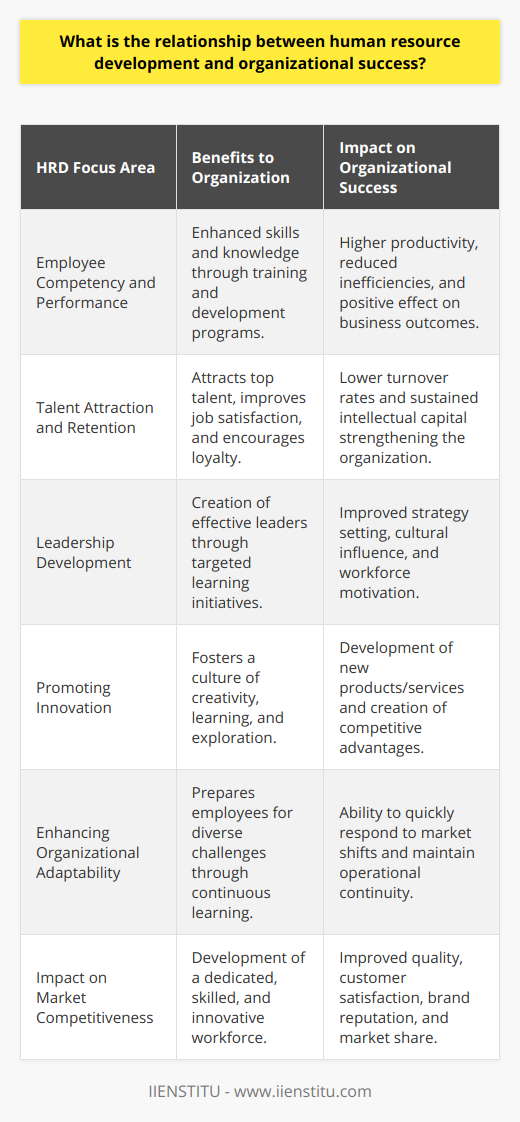
How do various human resource development strategies contribute to employee performance and satisfaction?
HRD Strategies for Enhanced Performance and Satisfaction
Employee Training and Development
Various human resource development (HRD) strategies play a crucial role in enhancing employee performance and satisfaction. For instance, training and skill development opportunities enable employees to acquire and improve the abilities needed for their roles. As a result, they become more competent and experienced, leading to increased productivity and job satisfaction.
Job Design and Work Environment
Another vital HRD strategy focuses on job design and the provision of a conducive work environment. This involves identifying and rectifying aspects that may hinder work performance or decrease job satisfaction, such as excessive workload, role ambiguity, or limited resources. Consequently, employees can efficiently execute their tasks, leading to improved employee morale and overall job satisfaction.
Career Development and Advancement
HRD strategies also encompass career development initiatives that enable employees to progress in their careers. By offering career counselling, performance appraisals, and promotion opportunities, employees feel motivated to excel in their current roles while also pursuing professional growth. This sense of direction and accomplishment contributes significantly to enhanced employee satisfaction and loyalty.
Recognition and Rewards
Effective HRD strategies entail the implementation of recognition and rewards systems that validate employee efforts and achievements. By acknowledging and celebrating employees' contributions, organizations foster a sense of appreciation and self-worth among staff members. When employees feel valued and respected, they exhibit higher satisfaction levels and better overall performance.
Work-Life Balance
Promoting a healthy work-life balance is another key aspect of HRD strategies. Providing flexible working hours, remote work options, and promoting a healthy work-life balance contribute to employees' mental and physical well-being. These initiatives result in reduced stress and burnout, allowing employees to achieve higher job satisfaction and enhanced work performance.
In conclusion, various HRD strategies contribute to employee performance and satisfaction by addressing different aspects of employees' work experiences. By investing in the professional development, well-being, and recognition of employees, organizations can build a satisfied, motivated, and high-performing workforce.
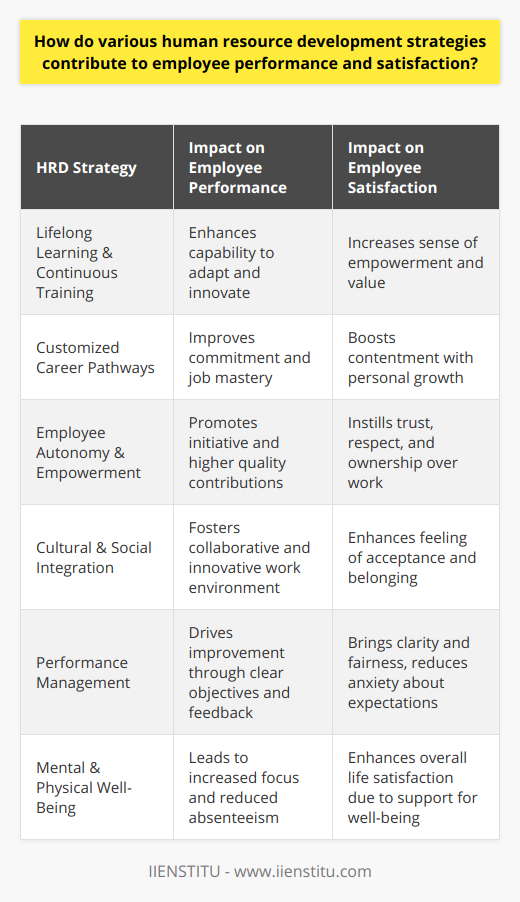
In what ways does human resource development align with broader organizational goals and objectives?
Alignment of HRD with Organizational Goals
**Role of HRD in Goal Achievement**
Human Resource Development (HRD) plays a critical role in achieving organizational goals by nurturing the skills, knowledge, and abilities of employees. This fosters a highly competent workforce capable of meeting the challenges of the dynamic business environment. In addition, HRD contributes to talent management and succession planning that ensures the sustainable growth of the organization.
**Integration of HRD and Strategy**
To align HRD with organizational goals, organizations should integrate HRD initiatives in their overall business strategy. This entails identifying the skill gaps within the organization and developing training and development programs to address these gaps. Consequently, businesses can achieve improved performance, innovation, and efficiency through the strategic use of their human resources.
**Employee Engagement and Performance**
HRD also aligns with organizational goals by enhancing employee engagement and satisfaction levels. Through effective communication, motivation, and recognition programs, HRD fosters a positive work culture that promotes higher productivity and commitment from the employees. As a result, the organization can achieve its strategic objectives more efficiently with the support and dedication of its workforce.
**Adaptability and Continuous Learning**
In an ever-changing competitive landscape, organizations must remain adaptable and agile to sustain their growth. HRD facilitates the continual learning culture within the organization by offering employees resources and opportunities for professional development. This, in turn, equips the employees to respond effectively to changing business conditions and contribute to the organization’s long-term success.
**Strategic Talent Acquisition and Retention**
Finally, the alignment of HRD with organizational goals also extends to talent acquisition and retention. By designing comprehensive recruitment policies and employee benefits programs, HRD can attract the best talent that aligns with the company’s vision and values. Moreover, HRD initiatives, such as talent retention and succession planning, ensure the organization retains its competitive advantage in the industry.
In conclusion, HRD plays a pivotal role in aligning with organizational goals and objectives by fostering a skilled and motivated workforce, integrating HRD initiatives into overall business strategy, promoting employee engagement, enhancing adaptability through continuous learning, and implementing strategic talent acquisition and retention policies. By strategically aligning human resource development with the organization’s vision, businesses can achieve sustainable growth and success in the competitive global market.
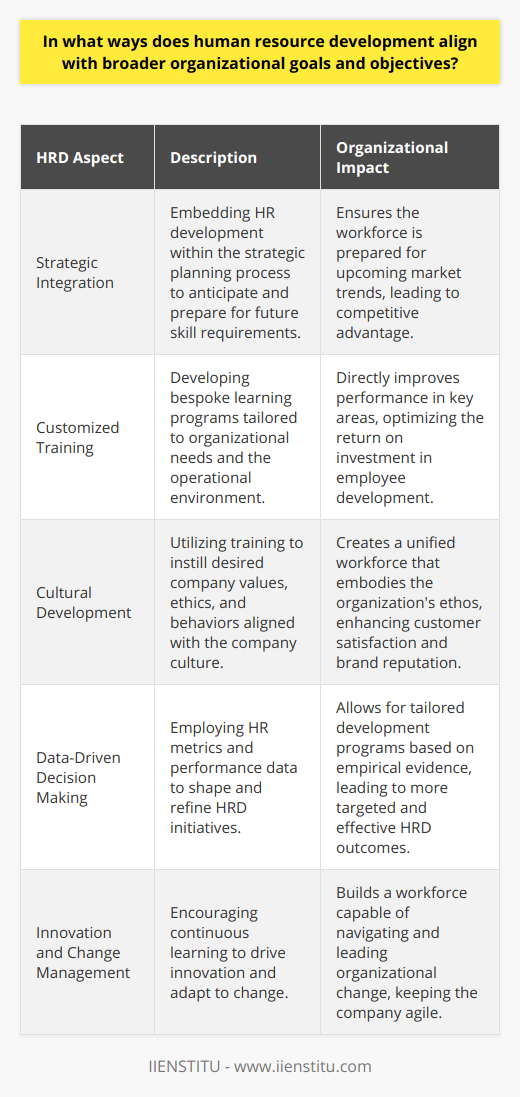
What are the essential components of effective human resource development programs?
Key Elements of Human Resource Development Programs
Understanding Learning Needs
The first essential component of effective human resource development (HRD) programs is the identification and evaluation of the learning needs of employees. This process involves assessing knowledge gaps, determining required job skills, and setting clear learning objectives. Additionally, understanding employees' personal and professional growth aspirations can help HRD programs support their overall development.
Focused Training and Development
In designing HRD programs, organizations must develop well-structured training content that is relevant to employees' needs. This includes tailoring learning resources according to employees' expertise levels and job requirements. Moreover, a blend of training methods, such as workshops, e-learning platforms, and mentoring, can help deliver a comprehensive learning experience.
Continuous Evaluation and Feedback
Monitoring the progress and outcomes of HRD programs is crucial to ensure their effectiveness. This involves tracking employees' learning progress, measuring the impact of training on job performance, and gathering feedback from participants. Organizations must use these insights to identify areas for improvement and make necessary adjustments to their HRD programs.
Flexible Learning Environment
Implementing flexible learning schedules and environments can increase the effectiveness of HRD programs. Options such as remote learning, on-demand training materials, and personalized learning paths can help employees easily access and complete required training while balancing their work responsibilities. Furthermore, providing support tools like discussion forums, help desks, and peer networks can enhance the learning experience.
Skill Application and Transfer
Finally, an effective HRD program should emphasize the application and transfer of skills acquired through training. Organizations must integrate learning outcomes with job responsibilities, allowing employees to apply newly gained knowledge in their roles. Additionally, promoting collaborative learning and knowledge sharing among team members can further enhance skill transfer and strengthen overall team performance.
In conclusion, effective HRD programs require a holistic approach that encompasses understanding learning needs, focused training and development, continuous evaluation and feedback, a flexible learning environment, and an emphasis on skill application and transfer. By integrating these components, organizations can cultivate a robust workforce that continuously adapts, grows, and excels in their roles.
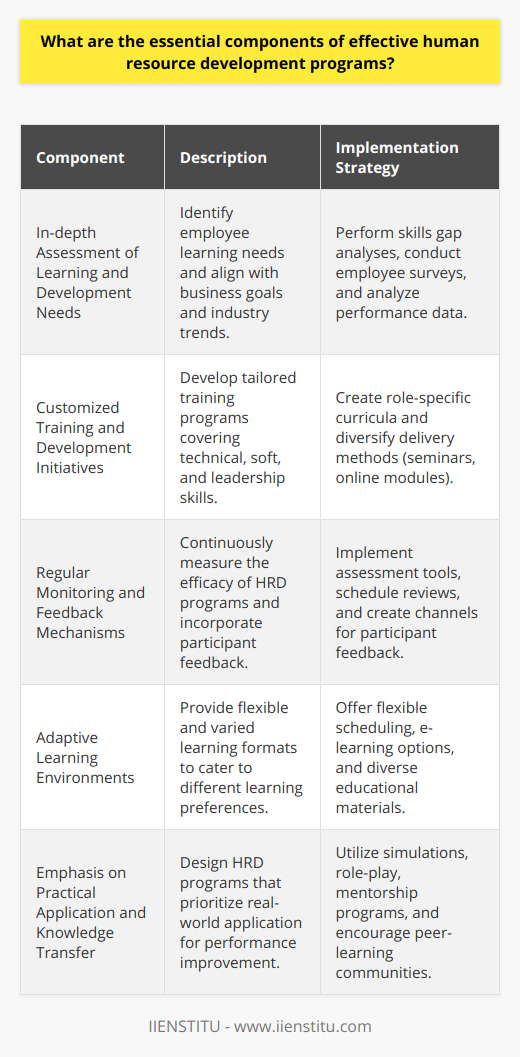
How does human resource development contribute to a country's overall economic growth and stability?
Role of Human Resource Development
Human resource development (HRD) plays a pivotal role in a country's overall economic growth and stability by enhancing the productivity and skills of the workforce. The core of HRD includes training, education, and health, which aim to nurture and develop the human capital, thus contributing to a country's economic prosperity.
Impact on Productivity and Innovation
A well-trained and educated workforce positively impacts productivity by working efficiently and effectively. Additionally, HRD influences innovation which leads to the creation of new products, services, and technologies, ultimately causing economic expansion. Investing in education and training also benefits individuals by increasing their employability and income, as skilled workers are in high demand in the job market.
Boosting Competitiveness
Human resource development is closely linked to the competitiveness of a country in the global market. A country with a skilled workforce attracts domestic and foreign investments, as businesses seek locations with a talent pool that guarantees the sustainability and growth of their enterprises. This investment influx, in turn, generates employment opportunities, leading to a cycle of economic growth and stability.
Social and Economic Inclusion
HRD promotes social and economic inclusion by reducing income inequality and unemployment rates. By providing equal access to quality education and training, individuals can break free from the cycle of poverty and contribute to the economic growth of their country. Moreover, investing in health and education reduces crime rates and fosters social cohesion, further contributing to overall stability.
Sustainability and Adaptability
Human resource development helps countries to adapt and respond to changing economic conditions and ensure long-term sustainability. By focusing on continuous learning and skill development, the workforce can remain relevant in the face of technological advancements, automation, and changes in the labor market. This adaptability is crucial for maintaining a country's competitiveness and stability in an ever-evolving global economy.
In conclusion, human resource development significantly contributes to a country's overall economic growth and stability by improving productivity, fostering innovation, enhancing competitiveness, promoting social and economic inclusion, and ensuring adaptability in the face of change. Investing in the education, training, and development of the workforce is essential for sustained, inclusive, and equitable economic growth.
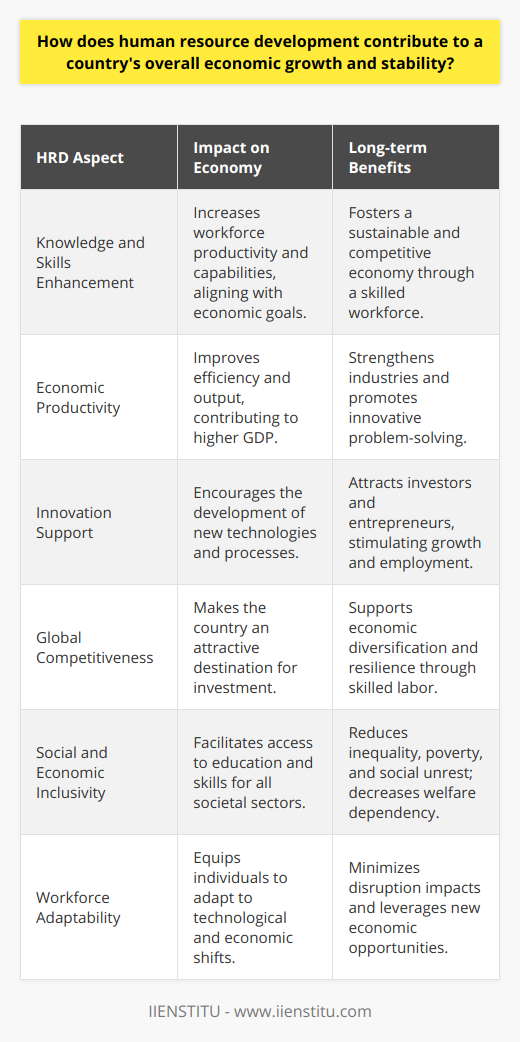
In what ways can human resource development practices impact employee retention and overall productivity?
Employee Skill Development
Human resource development practices affect employee retention and productivity through multiple avenues, such as employee skill development, support for creativity, work-life balance, and career progression. Promoting continuous learning enhances employees' skills and knowledge, making them more versatile and valuable for the organization. It also provides a sense of accomplishment and motivation, engendering loyalty towards the organization and reducing turnover rates.
Creativity and Innovation Support
Support for creativity within the workplace is another critical HR development practice that impacts retention and productivity. By cultivating an environment that encourages continuous innovation and experimentation, employees feel more engaged and challenged, contributing to a sense of belonging. Furthermore, this creative atmosphere propels the development of novel ideas and solutions, improving overall productivity and making the organization more competitive in the market.
Work-Life Balance Initiatives
Human resources can also promote employee retention and productivity through work-life balance initiatives. By providing flexible working hours, telecommuting options, or generous leave policies, organizations demonstrate a concern for employees' well-being. This supportiveness leads to increased job satisfaction, reducing the likelihood of employees seeking alternative employment opportunities. Additionally, employees with a healthy work-life balance prove to be more productive, reducing absenteeism and burnout rates.
Career Progression Opportunities
Lastly, human resource development practices can impact employee retention and productivity by offering clear and attainable career progression opportunities. By defining transparent pathways for advancement, organizations demonstrate an investment in their employees' futures. Employees, in turn, feel motivated to perform at their best, knowing that their efforts may lead to further growth within the company. This dedication translates to increased productivity and a stronger employee commitment, reducing turnover rates and minimizing recruitment costs.
In conclusion, organizations can maximize employee retention and productivity by implementing effective human resource development practices. By promoting skill development, creativity, work-life balance, and career progression, employees remain motivated, loyal, and engaged, leading to a more productive and competitive organization.
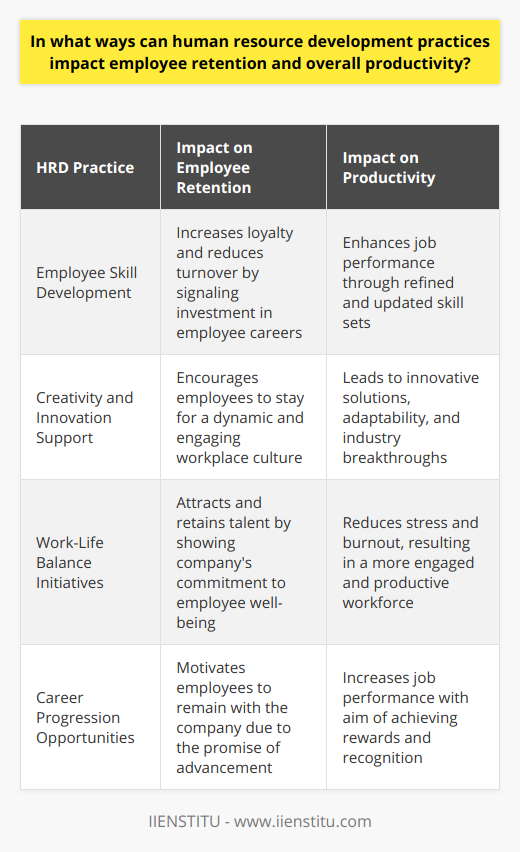
Why is human resources most important for ensuring the long-term sustainability of an organization?
Key Role of Human Resources
Human resources plays a pivotal role in securing the long-term sustainability of an organization. Their integral role comes from their function in managing the backbone of the organization: the employees.
Employee Recruitment and Retention
In order to assure continued operation, organizations must attract and retain qualified personnel. Human resources takes the helm by developing effective recruitment strategies, fostering a positive work atmosphere and implementing competitive compensation plans.
Performance Management
Performance management is also under the purview of human resources. They set up performance expectations and coach employees in achieving these goals, driving both business growth and employee satisfaction.
Employee Training and Development
Human resources oversees employee skill enhancement, which is key in keeping up with industry development. Through sourcing suitable training and development opportunities, they maintain the relevancy and efficiency of the workforce.
Regulation Compliance
Compliance with labor and employment laws is another crucial task of human resources. This avoids costly fines for non-compliance and maintains the organization's reputation, which impacts both internal and external relationships.
Conflict Resolution
Finally, by providing conflict resolution processes, human resources helps maintain a harmonious working environment. This, in turn, encourages productivity and minimizes potential disruptions.
In conclusion, human resources activities and initiatives are critical for ensuring organizations can adapt, innovate, and remain competitive in the long-term, underlining its importance in the sustainability of any organization.

What are the examples of human resource development that can enhance employee engagement and satisfaction?
Training Opportunities
Training and education opportunities work as a great example of human resource development that drives employee engagement. When employees receive regular training, they are more likely to perform better and feel satisfied. Such opportunities also foster career growth and development, leading to improved morale and productivity.
Mentorship Programs
Another example is the mentoring programs provided by HR within companies. Mentorship encourages the transfer of skills and knowledge from experienced employees to their less-experienced counterparts. This process promotes a culture of continuous learning, fosters engagement, and enhances employee satisfaction.
Performance Feedback
Performance feedback makes employees aware of their productivity and performance. When HR offers constructive performance feedback, it motivates employees to work harder towards their goals. It gives them a clear understanding of what they need to improve, making them feel more involved and satisfied.
Work-Life Balance
HR can take steps to ensure work-life balance for employees. Flexible working hours, remote work opportunities, and generous leave policies can help employees maintain their life outside of work. Good work-life balance significantly increases engagement and satisfaction among employees.
Leadership Development Programs
Leadership development programs are another beneficial HR initiative. Development programs equip employees with the skills to take on leadership roles. When employees see a clear path for advancement, it boosts their engagement and satisfaction.
Recognition Programs
Finally, HR-led recognition programs also enhance employee engagement and satisfaction. Recognizing and rewarding employees for their good work makes them feel valued and appreciated. It boosts morale, increases productivity, and leads to higher levels of job satisfaction.
In summary, these examples of human resource development all contribute to increasing employee engagement and satisfaction. By focusing on training, mentoring, work-life balance, leadership development, and recognition programs, HR departments can foster a more engaged and satisfied workforce.
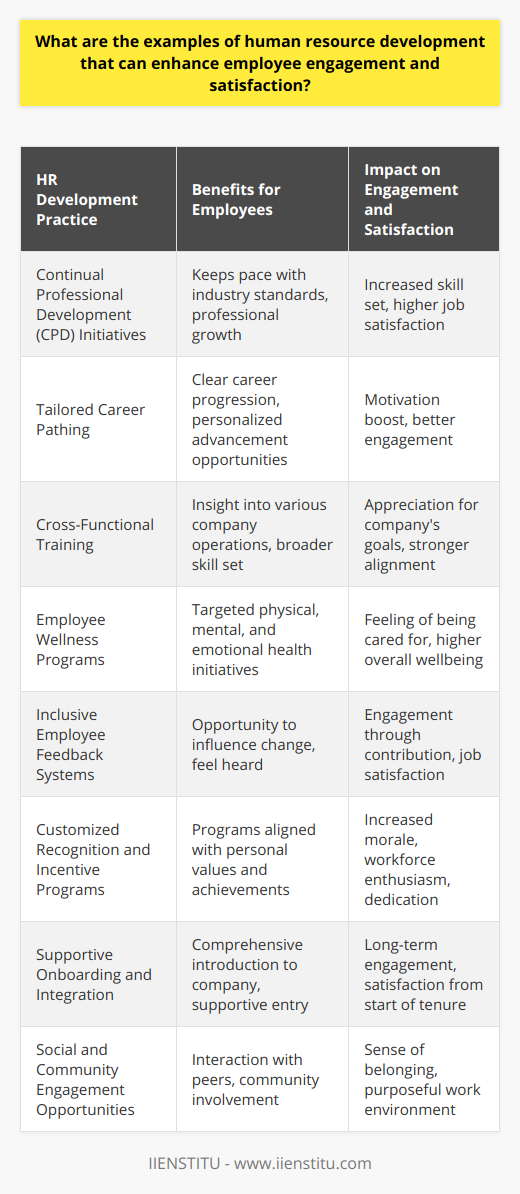
How do effective human resource development approaches contribute to fostering a positive organizational culture and work environment?
Empowering HR Development Approaches
Effective human resource development strategies play a significant role in creating a positive organizational culture and work environment. They aim at refining employees' skills, fostering their potential and improving their performance. Through such strategies, organizations can nurture an environment that encourages growth and continuous learning.
Impacts on Organizational Culture
Employee development programs directly influence an organization's culture. Employees feel valued when organizations invest in their growth. It fosters a sense of belonging, leading to increased loyalty towards the organization. Also, development programs encourage shared learning experiences, contributing to a collaborative and innovation-driven culture.
Creating Positive Work Environment
An effective human resource development approach also significantly contributes to creating a positive work environment. Employees who continually develop their skills are more likely to be satisfied with their work and show higher commitment. This positively impacts the overall morale in the workplace, leading to a healthier and more productive work environment.
Facilitating Employee-Management Relationships
Good human resource development strategies can also yield improved employee-management relations. As employees participate in development programs, they gain new perspectives and feel more closely aligned with the organization's vision. This helps bridge the communication gap between employees and management, fostering a sense of unity and mutual respect.
Conclusion
In conclusion, effective human resource development approaches are central to fostering a positive organizational culture and work environment. They help in empowering employees, enhancing productivity, and improving employee-management relationships. Therefore, embracing these strategies can significantly enhance an organization's overall performance and success in the long term.
